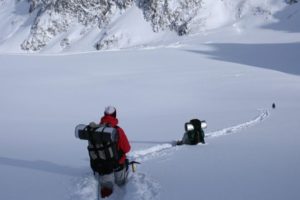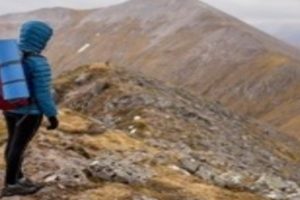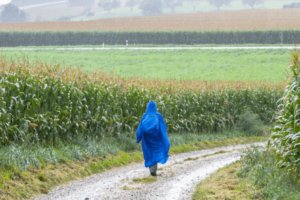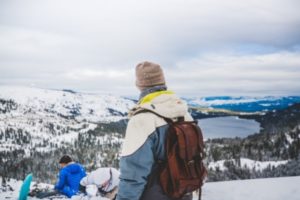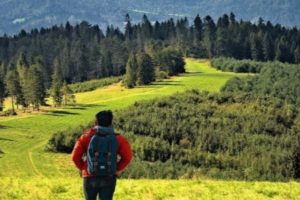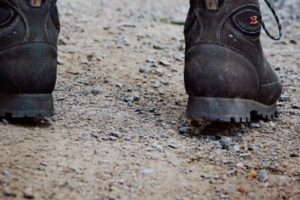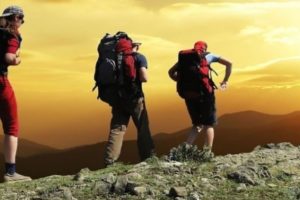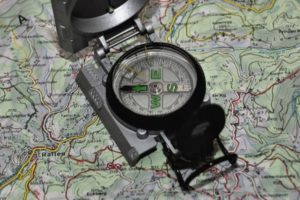Eating is one of my favourite things in life, but eating correctly, while camping, is often a challenging experience. The worst part of eating in the countryside is getting your food intake wrong. Either you end up hungry, or you’ve carried extra weight across the hills that you didn’t need to take.
Realistically, you’re going to need between 2,500 & 5,000 Calories per day, depending on you’re your weight and how strenuous your hiking route. It all starts with your planning but develops over time by understanding your own body and how many calories you need to function correctly.
Water Filtration or Purification Tablets
Make sure you start your hike fully hydrated and keep drinking water every 30-minutes no matter whether it’s hot or cold. Staying hydrated will help to keep your energy levels up and your body feeling great. Studies show you’ll need to drink a litre per hour walking up a hill on a sunny day.
On a long day in the countryside, it’s often difficult to carry enough water to get through the day. Remember, 1-Litre weighs, 1-Kilo, and during a long day, I’m likely to consume 6-litres of water meaning at the start of the day my bag has 6-kilos of extra weight to it.
Over the years, there have been a few times where I have carried five or six litre/kilos, however, a much easier route is to take a water filter system or purification tablets and refill your water supply as and when you find freshwater.
- Electrolyte Mix – This should be added to some of your water supply to help replenish the lost minerals throughout the day. On a personal basis, I have two water bottles, one that contains an electrolyte mix, and the other just plain water. I find that drinking too much Electrolyte mix gives me horrendous heartburn.
- Avoid Sugar – Make sure you’re focusing on nutrient-dense food that provides energy over the day. A mars-bar taste great, but it’s full of sugar and will only give you a short boost of energy. Proteins, Carbohydrates and Healthy fats will digest slowly and provide you with a steady supply of energy.
- Fresh Foods – From day two, it’s more than likely you’re going to be eating freeze-dry or dehydrated food. As a consequence, make sure you pack as much fresh food for the first day as possible. Fresh fruits and vegetables are a great way to start your first day in the mountains.
Estimation
The first thing you need to understand before you start to think about your food intake is how many calories you need. Obviously, this will depend on your weight, how strenuous your route is, how long you’ll be hiking for each day, and the weather (In the cold, you’ll burn more calories, than in the hot).
You can estimate the number of calories you need by working out your basal metabolic rate, or BMR using an online calculator. This will give you a guide of how many calories are required to keep your body functioning at rest.
While this is purely mathematical, it’s a great start allowing you to use this figure to start testing your personal calorie consumption. Let’s imagine you’re a 40-year-old guy at six-foot and weighing around 75kg. Your BMR is about 1736 calories per day.
If you weigh yourself on a Monday, eat 1736 calories per day, and your weight stays the same after a week, you have the right calories. If you lose weight, you need to increase your calories. Once you have this part mastered, the next part relies on a few educated guesses.
Calorie Intake
I use a scale of 1.25 for light, 1.50 for mid-range and 1.75 for hard days and I would times my daily BMR calorie intake by one of these numbers depending on how hard that days hike is likely to be. Something like a light day-hike would be 1.25, whereas a hard day on the mountains in the hill, I would times my BMR by 1.75. Again these are all ball-park numbers that need to be tried and tested.
Once you’ve worked out how many calories you need to consume each day, you can start selecting both the correct amount of food and the correct type of food. It’s vital that you always take a little bit of extra food in case you’re hungrier than usual on a specific day, or so that you don’t have to worry if your route takes longer than expected.
- Lightweight Food – Focus on lightweight food reduce your backpack weight. I’m a firm believer in reducing my pack weight as much as possible. There is no point in buying lightweight sleeping bags and tents, to then walk around with heavy cans of food. Focus your food on dehydrated or freeze-dried meals and any other bulky products should be split into re-usable plastic bags to save space.
- Dehydrated Vs. Freeze Dried – The key difference between dehydrated and Freeze-dried food is its liquid content and nutritional value. Freeze-dried food removes 99% of liquid, while Dehydrated is about 60-70%. This allows freeze-dried food to be stored for long and cooked much quicker. Most importantly, it retains the taste and texture, whereas dehydrated food, needs to be cooker rather than just heated, and ends ups being almost chewy.
- Dry Foods – Dry foods like rice, instant noodles and soup mixes are some of the best lightweight hiking foods and take up very little space in your pack. These easy-to-make foods can also become creative meals when combined with dried vegetables, beans or spices.
- Wet Food – Typically they weigh double that of dry food, but you can eat them on the go, hot or cold. While I probably would not pack my bag full of wet food, they serve their purpose, and I always carry a couple of portions in my bag.
- Spices – The key downside of freeze-dried or dehydrated food is that it’s often very dull. As much as you try to add flavour to freeze-dried food, the fact that you’re freeze-drying your food removes a lot of the taste. It’s, therefore, a great idea to bring with you a selection of different spices to add flavour to your meals. Salt, pepper, garlic powder, basil, cayenne pepper, cinnamon or even a small plastic bottle of olive oil.
Recommend Food
The best food will have a high calorie-to-ounce ratio, be easy to prepare, and most importantly, can be made in one pot. Personally, I like a mixture of wet and dry food, below are my favourites.
- Vango.co.uk – is one of the best UK brands and makes a selection of food options. They are ‘wet’ food which means they’re heavier than a freeze-dried option, but it’s great to have in your backpack knowing that you can eat hot or cold. They typically weigh around 300 grams each and provide around 400 Calories. My favourites are the All Day breakfast, Steak and Vegetables, and the Chili Con Carne and Rice, although watch out for the chocolate pudding, its amazing, but leaves you wanting more. The downside is only one veggie option throughout the whole range.
- Blå Band Expedition Meal Series – is a Scandinavian brand that was initially developed through collaboration with the Swedish military and has a great selection of freeze-dried food for both meat-eaters and vegetarians. The food bags need approximately 400ML of boiling water and about 10 minutes of sitting time to be ready to eat. The bags weigh about 140grams dry and provide about 600 calories. Favourites include Pasta with Cheese and Broccoli, Pasta Carbonara and Pasts with Tomato and Cheese.
- Expedition Foods – are part of the old guard of freeze-dried food given they have been providing food options to explorers, endurance athletes and mountaineers, across the world since 1995. They have three options from a regular 450 Calorie food portion up to an extreme high energy food portion providing upwards of a 1,000 calories per meal.
Example Daily Food Intake
Breakfast is the first meal of the day and on a cold morning, your first chance to start warming your body. If it’s mid-summer and you’re lucky enough to get a beautiful hot day, a cold breakfast could work, but in general, when I’m on the mountain, I wake up cold and want a hot breakfast to start the day. Usually, I’m trying to eat around 800 calories at breakfast which consists of the following;
- Hot Coffee (Starbucks Via) or Tea (Bengal Spice) and Powdered Milk (Nido) – Minimal Calorie Intake
- Instant oatmeal (Quaker), usually with a light covering of sugar or chocolate to make it taste great – 150 Grams of Instant Oatmeal is 450 Calories and another 100 in the sugar or chocolate source. I would make it with water. An all-day breakfast from Vango is 412 calories, or a Porridge and Blueberry from Expedition Food is 450 Calories.
- Energy Bars such as Clif Bar (Chocolate Almond Fudge or Chocolate Chip) is around 250 Calories.
Lunch / Snacks
Often I don’t eat a specific lunch in the mountains. If I’m on a two-day trip and you can have fresh for both days, I will pack a couple of sandwiches for each day, with something like meat a cheese for day one, and peanut butter or honey for day two (Meats will typically last two days if it’s cold, if not a peanut butter sandwich which works great).
For longer hikes, I simply focus heavily on my snacks for lunch. Mountain snacks are an essential part of your daily calorie intake and can be a great source of motivation and energy when you’re slogging it up a hill in the rain. Snacks come in three different types;
- Nutrition Bars or Energy Gels that provide a significant source of proteins, carbohydrates, vitamins, minerals and healthy fats are the best, but make sure they’re sugar-free. Sugar is its basic term does nothing for you in the long term. You might get a quick boost of energy, but it won’t last long. There are some calorie-light bars, but most weigh about 70-grams and provide 250 calories per bar.
- Fresh or Dried Fruit and veggies are great for your backpack where space is limited. My personal favourite is dried bananas, however, I heard people drying everything from apples to seaweed. It’s light, sugar-free and tastes great. There is typically 360 calories per 100 grams of dried fruit.
- Seeds and Nuts are one of the best sources of proteins and have a great calorie-per-ounce ratio which is perfect for hikes in the countryside. 100 Grams of mixed nuts us about 600 calories, however Hazelnuts and walnuts have the highest calorie-per-ounce ratio.
Example Dinner
I always stick to Freeze-Dried or Dehydrated meals in the evening. They are light, have an excellent calorie-per-ounce ration and if you choose well, taste great. Recently I walked up Scafell Pike with a friend who packed two days of lunches and dinners that he made at home.
For day one he had a lasagne and vegetables, and for day two, spaghetti bologna. His rationale was it was far cheaper to pre-cook, but it weighed three kilo’s (total food for the weekend), and on top, we carried four-litres of water. This is compared to my freeze-dried food which cost three times as much (Around 6 per meal) but weighed less than 1 kilo. The choice is yours.
- Starters – These include instant soups (A large cup is around 100 calories)
- Main Meels – Freeze-dried or Wet meal pouches such as those from Vango, Expedition Foods and Bla Bland above. (Most bags are 450 Calories)
- On the Side – Top this up with Instant Mashed Potatoes, Pasta and Rice Sides, Couscous, Dehydrated Vegetables (Just Veggies)
- Favourite Desserts – include chocolate mousse,
What Kitchen Equipment Should You Carry?
This is very much a personal choice. When I’m camping in the countryside, I try to pack as light as possible meaning that the kitchen equipment does vary depending on the time of the year and whether we’re going to cook meals in a pot or meals in a bag. For stoves, we’re looking for a system that has excellent simmer control while also being able to bring water to a boil fast.
- One Person Stove – The MSR PocketRocket 2 Stove works perfectly if I want something for myself. It works down to -6 degrees and including the fuel canister weighs only 413 grams. It works great with a MSR Titan Kettle (0.85-Litres, while weighing 118-grams). Attached to this I would use a Coleman C100 Cartridges which on average, has a boil time of 2m 30sec per 0.5 litres and will boil 15 litres per 100g of fuel.
- Two Person Stove – If you need something slightly bigger, try the MRS Titan 2 Pot Set. The set contains two pots, a 1-litre kettle and a 1.5-litre pan.
- Cutlery – Two choices here, if you want a full cutlery set, I’d buy the Toaks Titanium 3-Piece Cutlery Set which is a lightweight three-piece set that you can use. However, that said, I often just take a Fork/Spoon combo. Over the years I’ve tested a few, of which my current favourite is the Morsel XL Spork. Make sure you buy the XL; otherwise it’s not long enough to reach the bottom of a boil-in-the-bag.
- Food Storage – Ursack Allmitey which is made from virtually puncture proof laminated UHMWP and Kevlar and while is a little heavy at 360-grams, it does provide over 10-litres of storage.
- Oil/Sauce Storage – Freeze dried food is often pretty dull. As a result, I like to spice my food up with either spices or sauces. Humangear GoToobs Travel bottles are perfect. Each bottle holds about 100ml of liquid in a spill-proof bottle.
- Water Filtration – If you’re wild camping, you’re going to need to purify water in quantity and the easiest way is with the Platypus GravityWorks Water Filtration System.
- Sports Drink Tablets – My favourite is Nuun Electrolyte Tablets which I really feel add electrolytes, minerals and caffeine to help keep my hydrated in the countryside.
Final Thoughts
Feeding yourself in the countryside, whether your out for a day hike, or on a week long camping trip should not be difficult if you take the right approach to planning, while a the same time, learning from your past experiences.
Remember, there is nothing worse than walking back to the car starving because you haven’t taken enough food.
